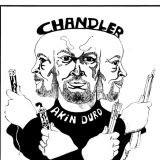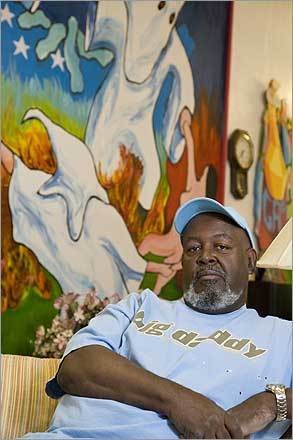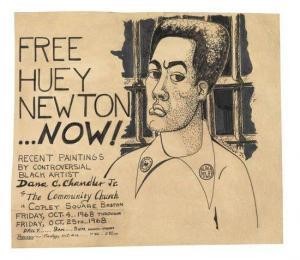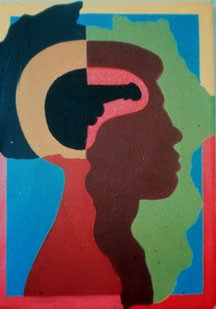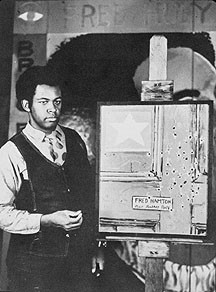Dana C. Chandler Jr. Artist and Activist
Protesting Institutional Racism at the MFA
By: Charles Giuliano - Feb 22, 2015
The Museum of Fine Arts is literally located across the tracks from the African American community in Boston. During the protest years of the late 1960s and 1970s the artist and activist, Dana C. Chandler, Jr., charged the museum with institutional racism. The proclamation was sent to the Boston print and broadcast media.
This initiated meetings with MFA administrators and talks that resulted in an exhibition "African American Artists from New York and Boston." Hired to curate the exhibition Edmund "Barry" Gaither was appointed an adjunct curator of the MFA while serving as director of the National Center for African American Artists in Roxbury (founded in 1968). The museum had started as a part of the Elma Lewis School of Fine Arts (founded in 1950) which suffered a series of fires leading to the destruction of the facility through arson.
In 1974 Chandler founded African American Master Artists- in- Residence Program (AAMARP) at Northeastern University.
A decade ago Chandler retired from teaching at Simmons College and relocated to Gallup, New Mexico.
Continuing an oral history project related to contemporary art and museums in Boston we spoke with Chandler. The dialogue revived lively differences of opinion about a complex era and its visceral agendas.
Charles Giuliano My concern is contemporary art in Boston and your involvement during the activist years of the late 1960s into the 1970s. My first encounter with your work was a mural. It was one of a number commissioned by the Summerthing project sponsored by Mayor Kevin White. Drew Hyde (later director of the Institute of Contemporary Art) was working with Edmund Childs an architect. They were creating pop up playgrounds in abandoned lots in the South End. Murals were a part of the program. I was trying to recall the location and date of the one you created.
Dana C. Chandler, Jr. Mass and Columbus Avenue before the Harriet Tubman house was there. If you go into the ICA archives there are postcards of the murals.
(Checked and was unable to find this reference.)
CG In Boston After Dark I wrote about Gary Rickson's murals on the exterior of the YMCA in Roxbury.
DC I think it's now on the rear wall of the YMCA. I may be wrong it may be on the front of the building.
CG There was a mural by Roy Cato, Jr. I don't think it still exists. They came and went.
(There was a Frank Phillips mural now gone.)
There was controversy about your mural and I recall that you came to see me about it in my office at Boston After Dark. You were also a participant in the Studio Coalition the first open studios event. There was a group shot of the artists on a roof top that became the image for a poster.
DC It appeared as the cover of a small magazine as well.
CG The Gallery Guide. There was also coverage in Art News as I recall.
DC It was a long time ago.
CG Can you recall your state of mind at that time?
DC It's best spoken of when I delivered that proposal to eradicate institutional racism at the Museum of Fine Arts. I felt that we were excluded. Of course I still feel that way. It was December of 1969. The article in Boston After Dark came out in January 1970.
CG Was that under your byline?
DC The article? No. That was written by somebody else.
CG Was there an involvement with Barry Gaither at that time?
DC He was not at the MFA at that time. He was hired around the time of the exhibition.
CG You are talking about the centennial year exhibition "African American Artists from New York and Boston" which was initiated by the artist Barney Rubenstein of the Museum School. It then got taken over by Barry. Is that correct.
DC I think it was a more collaborative thing. I think Barney knew a lot of the African American artists in New York. But Barry was more intimately involved with them. They were more his friends than Barney's. I think.
CG Were you in that exhibition?
DC Yes I was. I was the initiator of the exhibition. The museum had no intention of having that show prior to my delivering that proposal to eradicate institutional racism. At the same time I delivered it to the MFA I delivered it to every newspaper, television and radio station in the area at that time.
CG How many ran it?
DC Boston After Dark was the first to do a large article and after that the Globe and Herald. There were some television shows on it Channels, 4, 5 and 7. That was probably more when the exhibition was up.
CG Was this an actual protest with demonstrations at the MFA or was it delivered as a text?
DC It was delivered as a text and then I think there was some picketing. Someone went in and did some damage to a Rembrandt painting. I think that's what initiated my meeting with the board of directors of the museum. (George) Seybolt and all those people at the time.
CG I have to correct your facts. It wasn't a Rembrandt. I believe that the damaged painting was "Daughters of Edward D. Boit" by John Singer Sargent.
DC Ok. But the museum was concerned that black folks would run through the galleries slashing paintings and all that.
CG Didn't your actions inspire those fears given the climate of the time?
DC My proposal was not. What inspired someone to do that I have no knowledge of. I had nothing to do with that.
CG It was a time of radical protest. It was the era of Malcolm X and the Black Panther Party. It was the climate of the times and perhaps you were a reflection of that.
DC I was seen as a reflection of that. Yes.
CG How did you feel?
DC Of the time of protest?
CG Of the radical branch thereof.
DC Oh yeah.
CG For example Malcolm's mantra of "By any means necessary."
DC (pause) I'm thinking. No. I never had any thought or intentions of running through the MFA with knives or any of that foolishness. I had too much respect for the art. But, non violent protest? Yes.
CG But that (radical and violent protest) was in fact the imagery in your work at the time.
DC Oh yeah. But I wasn't going to make Molotov cocktails. The feeling of young African Americans at the time is very similar to what they feel today about Ferguson. That if there aren't changes made it can escalate. We also were aware that a lot of changes in the government were going to be made by COINTELPRO the ones that destroyed the Black Panther Party.
(COINTELPRO (an acronym for COunter INTELligence PROgram) was a series of covert, and at times illegal, projects conducted by the United States Federal Bureau of Investigation (FBI) aimed at surveying, infiltrating, discrediting, and disrupting domestic political organizations. National Security Agency operation Project MINARET targeted the personal communications of leading civil rights leaders, Americans who criticized the Vietnam War, including Senators (e.g., Frank Church and Howard Baker), journalists, and athletes.)
You can find a lot of that information on You Tube. It was a government organization put together by the FBI. There may have been other agencies. It was Hoover's intention to infiltrate radical organizations and destroy them. These are not my words.
CG Were you acting alone or were you a part of a group? Was there a committee?
DC No. I was pretty much acting alone. I got supported by any number of groups once that came out. The support was more verbal than actionable. The Perry Rathbones and people like that would call leaders in the black community and ask "Are we at fault here? Have we not done enough? Or have we done anything?" The activity of the MFA in the black community was nil. Until the Elma Lewis center came about. When they inquired of her asking "What the hell is going on? There's some crazy black folks." She responded "No these are people in our community who have noted that you have not given us our fair presence in the museum. How can you be across the street from the black community and not have any black artists on your walls?"
CG Was the MFA responding to threats?
DC The answer to that is yes. If it had not been for my proposal and hearing from people in the black community upon hearing of the Sargent (slashing) they said that they were not surprised. There's no indication as to who did it. And it certainly wasn't me. I wouldn't do such a thing. I like John's work.
CG I didn't realize that you were on a first name relationship with him. I didn't know that. You may have applied leverage at the right time. But there were other factors. It was the centennial year and exhibitions which had been planned fell through. So at the last minute there were gaps to fill in the program. There was a classical Greek show as well as a planned Egyptian show.
DC I spoke with Perry Rathbone about that. Maybe it was George Seybolt. I'm not sure.
First they were going to put the exhibition in the DD Galleries. Which is the student galleries. I said "no." If you do that I for one am not going to show. And we will picket you. There were artist friends of mine who were ready to do exactly that. It would not look too good during the centennial year. The title precluded upon the museum's 100th anniversary. In those hundred years there was no appreciable African American art there nor had there been exhibitions.
CG It was also historically true that contemporary art was not represented. Not just African American art. Other than Brahmin painters the arts of the immigration generations were not represented in the collection. (For example the Boston Expressionists who were primarily Jewish immigrants.)
DC You don't want to do that Charles. It's the same thing people are doing when it comes to Ferguson. When it's said that cops are killing black men it's said that well, cops are killing white men too.
CG The MFA had no strategy for contemporary art until 1971 when Ken Moffett was hired as curator. In addition to your protests there were also protests from the Boston Visual Artists Union as well as the dada action of artists sabotaging the museum with the event Flush with the Walls. I was an advocate for change through my column in Boston After Dark. There was a broad spectrum of artists putting pressure on the museum to show contemporary art.
DC Charles I don't want to be connected with that.
CG You don't have to be. I'm just setting the record straight.
DC You're setting your record straight. It has nothing to do with my record. I'm talking about what was happening with black people. I don't want to get bunched up with what was going on in the white community. I was no part of that at the time. What you're doing is a broader view of everything.
CG Ok, Is that good, bad or indifferent?
DC Not if you're African American. That's what European Americans always do. We tell them about our pain and then they want to include it in their pain. No. It's a different story. So please don't do that.
CG What you say is clear to me.
DC Then you're going to do what you do. You always have.
CG How do you feel about that?
DC What you doing what you always do?
CG Yes. Please.
DC It makes me very angry. It always has. Through the years part of my struggle with you has always been this business of you having some kind of larger vision about what's going on in the world. And somewhere in there you include us. It's a very kind of imperialist view. As far as I'm concerned.
CG You might as well add Colonialism. Imperialist/ Colonialist and post modern. Why not.
DC Ok I'll add that too. Yeah, pretty much.
CG I can live with that. Frankly it doesn't concern me because regarding journalism and art criticism there's a mandate to step back and take a broader overview. It's what we do. Our role is to report and evaluate rather than to advocate and take sides. We present facts and it is up to the reader to decide. We try to present the whole picture and connect the dots. Including the disenfranchised as a part of that dialogue.
DC Oh you are still the same amusing fellow you've always been.
CG I've always liked you too.
DC Yeah. I can tell. I still remember the things you wrote about my work.
CG Do you want to discuss that?
DC If you're going to include me and us in a broader view please include the fact that I personally do not want to be included in your broader view. I say that very clearly. I do not want to be included in your broader view. I think it's exactly what you said a nice Colonialist point of view. A point of view of including us in the broader picture of disenfranchised blah blah blah.
CG Looking at your work in the context of the late 1960s and 1970s, and what mainstream critics knew of African American art at that time, your work and imagery for that era may be viewed as emblematic.
Since then, obviously, there have been enormous changes. Today there are a number of A List African American artists; Kara Walker, Lorna Simpson, Carrie Mae Weems, Glenn Ligon, Ellen Gallagher, Nick Cave, Fred Wilson, David Hammons, Isaac Julian, Maria Magdalena Campos Pons, Kerry James Marshall to mention a few. On a global level there are the British artist Chris Ofilii and Yinka Shonibare as well as the African El Anatsui. In New York the Jack Shainman gallery represents leading African American as well as African artists.
There are a number of African American and African artists who are very successful in the mainstream art world.
DC The operative word is "since then." During my time there were not a lot of successful African American artists in America. They were beginning to see success but I would tend to say was because of those of us who struggled against the museums and galleries. People like Benny Andrews.
CG I knew Benny well and he was a friend. He was included in my show at the Provincetown Art Association and Museum called "Kind of Blue." There were four artists Benny, Bob Thompson, Emilio Cruz and Earle Pilgrim. The show moved to Northeastern where we held a colloquium with Barry Gaither, myself and Pat Hills. The then Yale graduate student Judith Wilson attended. (With Thelma Golden she co-curated the Bob Thompson show at the Whitney Museum.)
Since that era we are talking about I have gone back and looked at historical artists starting with Henry Ozawa Tanner, Horace Pippin, Jacob Lawrence, Charles White, Romare Bearden, the Harlem Renaissance. There are always new areas of interest and study which is a part of the Imperialist/ Colonialist, Post Modern overview that you strongly object to. I have looked before and after the protest years. So I'm not ignorant of African American art, music and culture.
DC I didn't say that. I didn't come close to saying that. To say that you are knowledgeable about American and European art and to have an overview of that. Of course you are. That's your field. I would expect that. Yes you have entered the African American art field and done some things. Yes. That was not what I said. It's what you heard but not what I said. I said the viewpoint in terms of this particular time is a very kind of Colonialist view. Including us in the whole vast realm of change that came about from around that time. Of which the people you just mentioned were a part. But they did not enjoy the kind of success that subsequently was enjoyed.
Charles (White) was one of the major artists. He was well known in the African American community but much more well known later. He became major in the American art community. The same with John Wilson and Calvin Burnett. They got much more play after this so called revolutionary struggle.
It's like what's happening in Ferguson. There was leadership there prior to that but it is now getting national attention. National attention brings change. There wasn't any national attention prior to that.
CG Let's not forget Alan Crite.
DC Oh I would never forget Alan.
CG He was seminal to the Boston artists community. Boston had a rich jazz history. Harry Carney and Johnny Hodges from the Duke Ellington band came from here. There were the after hours spots like the Pioneer Club. Copley Square had Storyville, Mahogany Hall, The Stables and further down Huntington Avenue the Brown Derby and High Hat. In Roxbury there was Estelle's and Connelly's. Sam Rivers and Tony Williams grew up here. There were great white players like Herb Pomeroy, Serge Chaloff, and Dick Twordzic.
I remember going to Storyville and being struck by the walls being painted in arcs of Black, Brown and Beige which quoted a famous Ellington tune. At the time it was remarkable to see a mixed audience listing to the music. That changed later and you saw few black folks at jazz clubs and concerts. Something happened.
DC I was probably in the crowd somewhere.
CG These are complex cultural issues. I don't think we should engage in thumbnail catch phrases like Colonialism. We don't need labels. They get in the way of taking a deep look at what was really going on. What were our roles in all of that?
DC Fine. That's how you see it. You see yourself as living in a larger world. I'm seeing it from the other end. I'm talking as one of those artists who was not a part of the American Scene and that's fine. African American artists of that time were not a part of the American Scene if you are doing a historical thing.
We were not a part of that scene and then subsequently were. If you're doing a historical piece that's the aspect I'm interested in talking about. That we would be the catalyst for all of those artists you mention. The Walkers and all those folks. Subsequent to where we were at that time. A lot of them would be much better artists than we are. There is a richer world history that now includes the African American experience. We are very happy and proud of our role in that respect. We were the artists of the moment even though our work was not of the caliber of later artists. We knew that we would be seen as the revolutionaries of the last century. All of that kind of stuff. We knew that. We looked forward to and saw Carrie Weems and all the other folks who came after. Their fame grew as the result of the things that we did. Because it was no longer unusual to have African American artists in shows.
CG To what extent were the social realists of the 1930s an influence on your work? Jacob Lawrence would be a part of that. But also artists including Ben Shahn, Philip Evergood, Robert Gwathmey. One could talk about a broad spectrum of artists including Jewish immigrants dealing with the Great Depression, social and economic inequity. They were on the front lines of dissent and protest. As a protest artist do you have an empathy or attraction to their work?
DC Why must I?
CG Because of an affinity with what they were trying to achieve in their work. They were using their art to express social and political concerns. There is the art historical term The Concerned Artist.
DC Their social and political concern was not for black people.
CG Is that the only thing that interests you?
DC I'm interested in correctness. If you want to talk about a subject let's be correct about it. It doesn't mean that I wasn't interested in their work. I was interested in Picasso, Cezanne and a whole bunch of other folks as well. They weren't interested in black people. They were interested in African art and to use that as a tool to change how European art was expressed when it came to figurative art.
CG How would you respond to Ben Shahn's works on Sacco and Vanzetti?
DC I would have responded better if he had did work on lynching in the south.
CG Shahn traveled and photographed in the south as a part of the Farm Security Administration program during the Depression. He made compelling images that dealt with racism. He was an artist expressing a broad range of concerns.
During the time when Jan Fontein was director I recall a demonstration and protest in the lobby of the MFA. Is that true and what were the circumstances?
DC It's true. It was around presenting a kind of history of American art.
("A New World: Masterpieces of American Painting 1760-1910" The Museum of Fine Arts, September 7 to November 13, 1983, The Corcoran Gallery of Art, December 7, to February 12, 1984, Grand Palais, Paris, March 16 to June, 1984. Organized by the MFA. curated by Theodore E. Stebbins, Jr., Carol Troyen, and Trevor F. Fairbrother. With essays by Pierre Rosenberg and H. Barbara Weinberg. )
It was a long time ago and I'm trying to remember the name of the exhibition. I think they did not include any African American, Asian American or Native American art in the project. It was all white American art. There was a protest and I think it was pushed by Ed Strickland. We were addressing including African American artists and I believe we were speaking to other inclusions of people of color. I don't remember that happening. I think it included a Henry Ozawa Tanner. (A painting may have been added but a Tanner is not included in the catalogue.)
CG Can you recall some of the artists you were interacting with in the late 1960s and 1970s? Who are the individuals we should be aware of?
DC John Wilson and Calvin Burnett. Calvin was interested in being more active in social statement. I was doing a lot of stuff with New York artists like Benny Andrews. It's hard to remember it was a very long time ago for me. We are not young.
CG (laughing) May I ask your age?
DC 74.
CG Same here. Born in 1940.
DC I'm getting a call from my family. Can you call me back.
Interview with Edmund Barry Gaither.

